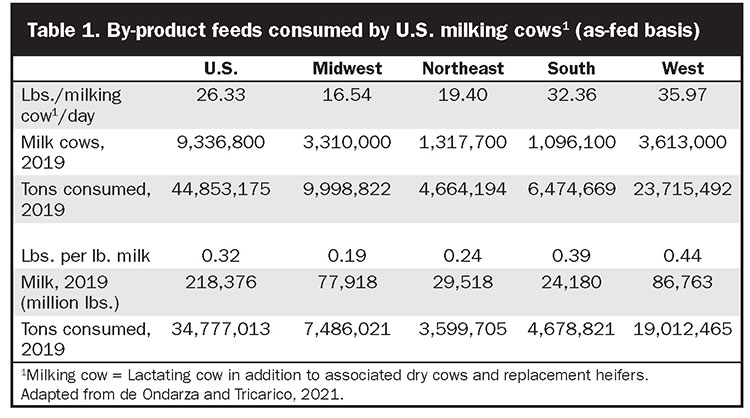The author has a dairy nutrition consulting business, Paradox Nutrition LLC, in West Chazy, N.Y.

The good news is that dairy cows very capably recycle nutrients from feed by-products into nutritious milk. As with everything the cow eats, a portion of the feed by-product is converted into methane and nitrous oxide. These non-CO2 greenhouse gases (GHG) contribute to global warming. But, since by-product feeds replace forages and grains that would otherwise be included in the dairy cow’s diet, very little additional non-CO2 GHG emissions are generated.
By-product feeds have been fed to dairy cows for decades, but previous surveys do not adequately put a figure on their use in today’s U.S. dairy diets. As a dairy community, we want to know and effectively communicate our positive environmental story. For this reason, Dairy Management Inc. sponsored a research project (de Ondarza and Tricarico, 2021) to:
- Understand what types of by-products and how much of each type are fed per U.S. milking cow.
- Quantify non-CO2 GHG emissions resulting from feeding by-products to milking cows and compare these emissions to those from other by-product disposal methods.
- 3. Quantify the nutritional contributions by-products make to U.S. lactating cow diets.
By-product feeds survey
Questionnaires were sent to U.S. dairy nutrition consultants and feed industry representatives about their use of 63 different by-product feeds throughout dairy rations. We also asked about the number of lactating cows and milk production of their clients’ dairies. Overall, returned survey results described 34% of U.S. lactating cows and 36% of U.S. milk production in 2019, making this the most comprehensive survey of U.S. dairy by-product feeding.

Each day, American dairy cows consume 26.3 pounds as-fed or 18 pounds on a dry matter basis (DM) of feed by-products per milking cow. This equates to 0.32 pound as-fed (0.22 pounds DM) of feed by-products per pound of milk produced as illustrated in Table 1. Cows in the West consume the most by-products (36 pounds as-fed per milking cow) followed by the South, Northeast, and Midwest, reflecting regional variations in by-product cost and availability of by-product and whole grains, as well as regional differences in the ability to manage feed by-products on the farm.

In 2019, U.S. milk cows ate 35 million to 45 million tons (as-fed) of feed by-products based on extrapolations from either USDA’s milk production or milk cow numbers. Corn distillers grains are fed at the highest rate of all by-products, with a U.S. average of 3.09 pounds of dry matter fed per milking cow each day. That is followed by canola meal at 3 pounds (DM per milking cow each day) and soybean meal at 2.71 pounds (DM per milking cow each day) as shown in Table 2. Feed by-products provide valuable nutrients, with the U.S. average by-product blend containing 30% crude protein, 30% NDF, 11% sugar, and 7% fat (DM basis).
The bigger picture
Feed by-products make up 32% of the U.S. lactating cow diet, ranging from 27% in the Northeast to 36% in the West (Table 3). Feed by-products are responsible for 36% of the non-CO2 GHG emissions generated by U.S. lactating dairy cows, ranging from 38% in the West to 34% in the Northeast. Feed by-products supply 54% of the crude protein needed by U.S. lactating cows, 61% of the sugar, and 46% of the dietary fat.

By-product feeds contribute to enteric and manure non-CO2 GHG emissions like all other feeds in the cow’s diet. Since by-product feeds replace forages and grains in the diet, their impact on non-CO2 GHG emissions is obtained after subtracting the emissions from the forages and grains replaced in the ration.
Overall, feeding by-products to dairy cows results in considerably less non-CO2 GHG emissions than landfill disposal (49-fold) and composting (4.7-fold) while supplying valuable nutrients that cows turn into milk for human consumption. The U.S. Environmental Protection Agency (EPA) considers recycling food surplus and by-products into animal feed as a preferred choice over composting, burning, and landfill. To better understand that perspective, review the figure.





